BTEC Level 5: Managing Personal and Professional Development Report
VerifiedAdded on 2023/04/11
|11
|2368
|209
Report
AI Summary
This report, a student submission available on Desklib, explores the multifaceted aspects of personal and professional development. It begins by examining trends influencing the need for professional development, such as technological advancements, market changes, and shifts in management, emphasizing the importance of adapting to new environments and the value of setting personal values. The report delves into the significance of career planning, personal goals, and the impacts of workplace changes on professional growth. It then assesses the value of professional networks, professional bodies, and outlines a step-by-step approach to implementing a personal development plan, including goal definition, prioritization, SWOT analysis, and skill development. Furthermore, the report explores learning styles and their contribution to development planning, along with prioritizing development activities and the effectiveness of mentoring and self-directed learning. Finally, it explains the implementation of a personal development plan through profiling, strategy definition, action plan improvements, self-assessment, learning methods, and evaluation, offering a comprehensive guide to personal and professional growth.
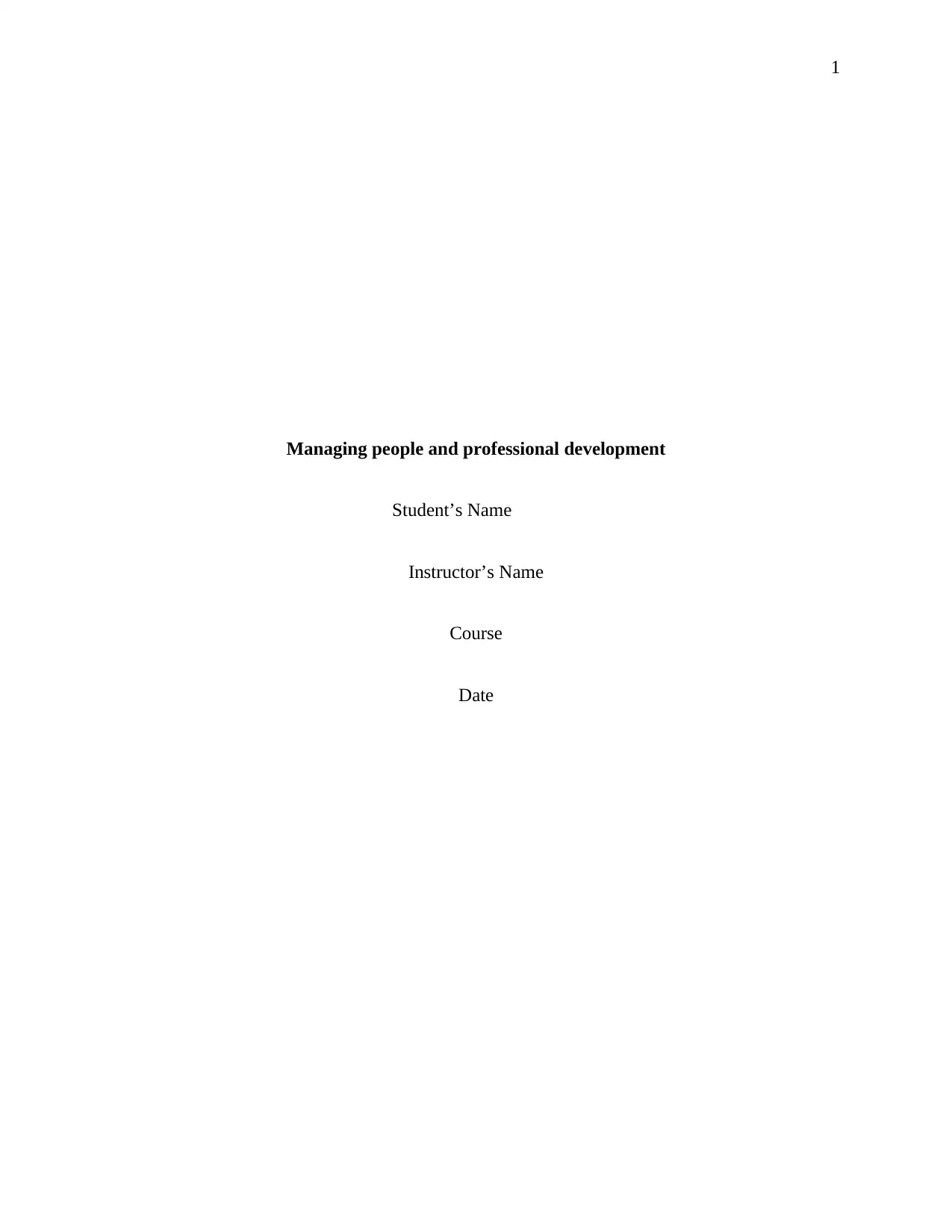
1
Managing people and professional development
Student’s Name
Instructor’s Name
Course
Date
Managing people and professional development
Student’s Name
Instructor’s Name
Course
Date
Secure Best Marks with AI Grader
Need help grading? Try our AI Grader for instant feedback on your assignments.
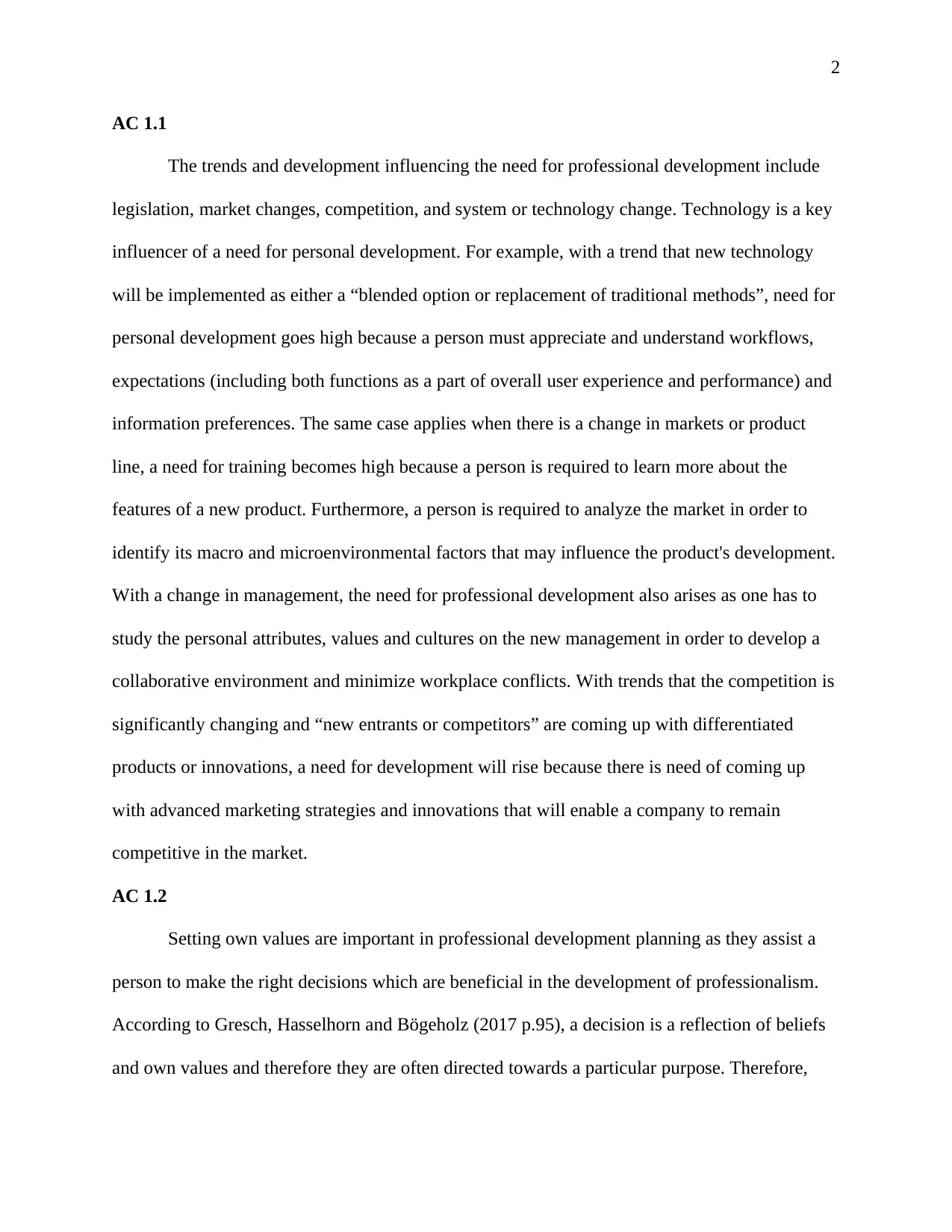
2
AC 1.1
The trends and development influencing the need for professional development include
legislation, market changes, competition, and system or technology change. Technology is a key
influencer of a need for personal development. For example, with a trend that new technology
will be implemented as either a “blended option or replacement of traditional methods”, need for
personal development goes high because a person must appreciate and understand workflows,
expectations (including both functions as a part of overall user experience and performance) and
information preferences. The same case applies when there is a change in markets or product
line, a need for training becomes high because a person is required to learn more about the
features of a new product. Furthermore, a person is required to analyze the market in order to
identify its macro and microenvironmental factors that may influence the product's development.
With a change in management, the need for professional development also arises as one has to
study the personal attributes, values and cultures on the new management in order to develop a
collaborative environment and minimize workplace conflicts. With trends that the competition is
significantly changing and “new entrants or competitors” are coming up with differentiated
products or innovations, a need for development will rise because there is need of coming up
with advanced marketing strategies and innovations that will enable a company to remain
competitive in the market.
AC 1.2
Setting own values are important in professional development planning as they assist a
person to make the right decisions which are beneficial in the development of professionalism.
According to Gresch, Hasselhorn and Bögeholz (2017 p.95), a decision is a reflection of beliefs
and own values and therefore they are often directed towards a particular purpose. Therefore,
AC 1.1
The trends and development influencing the need for professional development include
legislation, market changes, competition, and system or technology change. Technology is a key
influencer of a need for personal development. For example, with a trend that new technology
will be implemented as either a “blended option or replacement of traditional methods”, need for
personal development goes high because a person must appreciate and understand workflows,
expectations (including both functions as a part of overall user experience and performance) and
information preferences. The same case applies when there is a change in markets or product
line, a need for training becomes high because a person is required to learn more about the
features of a new product. Furthermore, a person is required to analyze the market in order to
identify its macro and microenvironmental factors that may influence the product's development.
With a change in management, the need for professional development also arises as one has to
study the personal attributes, values and cultures on the new management in order to develop a
collaborative environment and minimize workplace conflicts. With trends that the competition is
significantly changing and “new entrants or competitors” are coming up with differentiated
products or innovations, a need for development will rise because there is need of coming up
with advanced marketing strategies and innovations that will enable a company to remain
competitive in the market.
AC 1.2
Setting own values are important in professional development planning as they assist a
person to make the right decisions which are beneficial in the development of professionalism.
According to Gresch, Hasselhorn and Bögeholz (2017 p.95), a decision is a reflection of beliefs
and own values and therefore they are often directed towards a particular purpose. Therefore,
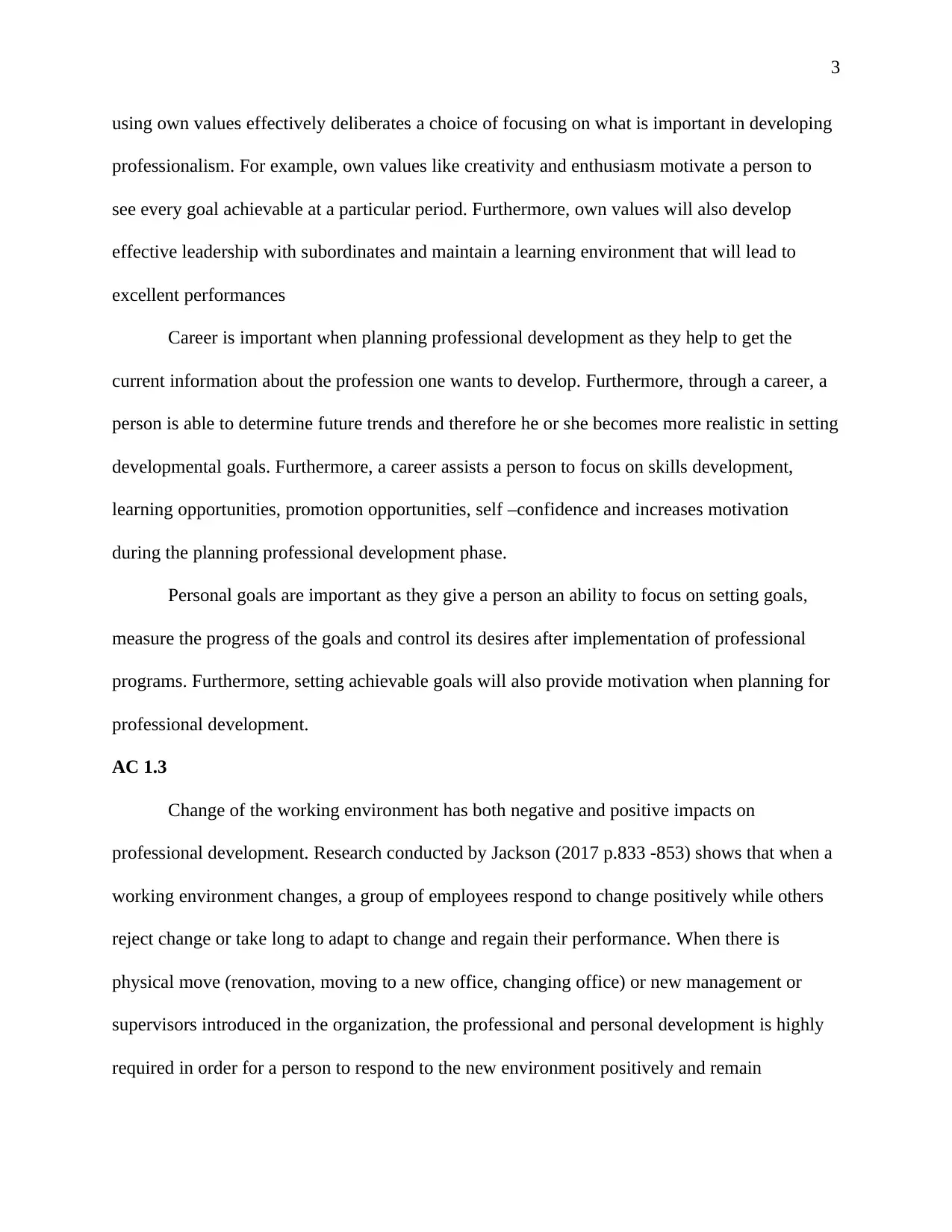
3
using own values effectively deliberates a choice of focusing on what is important in developing
professionalism. For example, own values like creativity and enthusiasm motivate a person to
see every goal achievable at a particular period. Furthermore, own values will also develop
effective leadership with subordinates and maintain a learning environment that will lead to
excellent performances
Career is important when planning professional development as they help to get the
current information about the profession one wants to develop. Furthermore, through a career, a
person is able to determine future trends and therefore he or she becomes more realistic in setting
developmental goals. Furthermore, a career assists a person to focus on skills development,
learning opportunities, promotion opportunities, self –confidence and increases motivation
during the planning professional development phase.
Personal goals are important as they give a person an ability to focus on setting goals,
measure the progress of the goals and control its desires after implementation of professional
programs. Furthermore, setting achievable goals will also provide motivation when planning for
professional development.
AC 1.3
Change of the working environment has both negative and positive impacts on
professional development. Research conducted by Jackson (2017 p.833 -853) shows that when a
working environment changes, a group of employees respond to change positively while others
reject change or take long to adapt to change and regain their performance. When there is
physical move (renovation, moving to a new office, changing office) or new management or
supervisors introduced in the organization, the professional and personal development is highly
required in order for a person to respond to the new environment positively and remain
using own values effectively deliberates a choice of focusing on what is important in developing
professionalism. For example, own values like creativity and enthusiasm motivate a person to
see every goal achievable at a particular period. Furthermore, own values will also develop
effective leadership with subordinates and maintain a learning environment that will lead to
excellent performances
Career is important when planning professional development as they help to get the
current information about the profession one wants to develop. Furthermore, through a career, a
person is able to determine future trends and therefore he or she becomes more realistic in setting
developmental goals. Furthermore, a career assists a person to focus on skills development,
learning opportunities, promotion opportunities, self –confidence and increases motivation
during the planning professional development phase.
Personal goals are important as they give a person an ability to focus on setting goals,
measure the progress of the goals and control its desires after implementation of professional
programs. Furthermore, setting achievable goals will also provide motivation when planning for
professional development.
AC 1.3
Change of the working environment has both negative and positive impacts on
professional development. Research conducted by Jackson (2017 p.833 -853) shows that when a
working environment changes, a group of employees respond to change positively while others
reject change or take long to adapt to change and regain their performance. When there is
physical move (renovation, moving to a new office, changing office) or new management or
supervisors introduced in the organization, the professional and personal development is highly
required in order for a person to respond to the new environment positively and remain
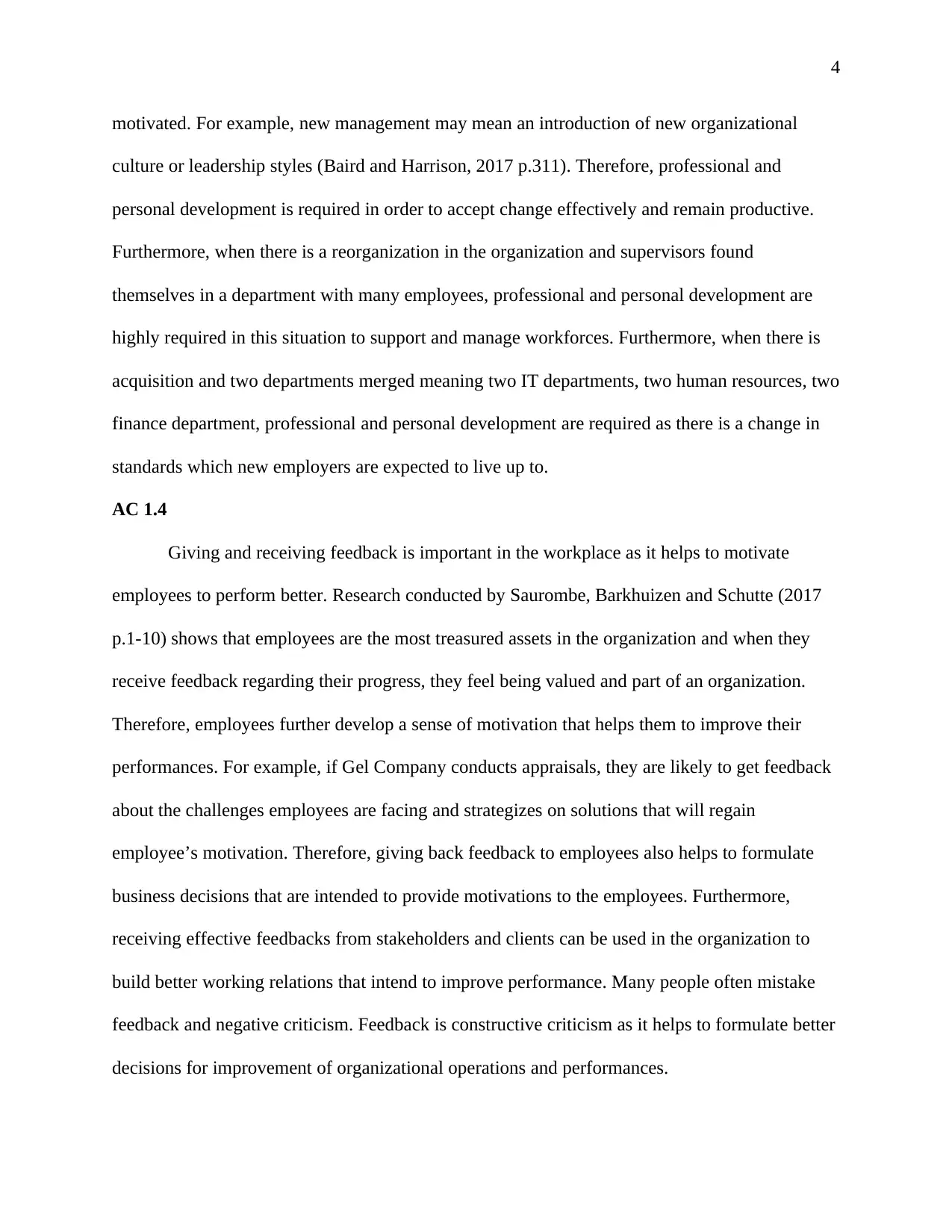
4
motivated. For example, new management may mean an introduction of new organizational
culture or leadership styles (Baird and Harrison, 2017 p.311). Therefore, professional and
personal development is required in order to accept change effectively and remain productive.
Furthermore, when there is a reorganization in the organization and supervisors found
themselves in a department with many employees, professional and personal development are
highly required in this situation to support and manage workforces. Furthermore, when there is
acquisition and two departments merged meaning two IT departments, two human resources, two
finance department, professional and personal development are required as there is a change in
standards which new employers are expected to live up to.
AC 1.4
Giving and receiving feedback is important in the workplace as it helps to motivate
employees to perform better. Research conducted by Saurombe, Barkhuizen and Schutte (2017
p.1-10) shows that employees are the most treasured assets in the organization and when they
receive feedback regarding their progress, they feel being valued and part of an organization.
Therefore, employees further develop a sense of motivation that helps them to improve their
performances. For example, if Gel Company conducts appraisals, they are likely to get feedback
about the challenges employees are facing and strategizes on solutions that will regain
employee’s motivation. Therefore, giving back feedback to employees also helps to formulate
business decisions that are intended to provide motivations to the employees. Furthermore,
receiving effective feedbacks from stakeholders and clients can be used in the organization to
build better working relations that intend to improve performance. Many people often mistake
feedback and negative criticism. Feedback is constructive criticism as it helps to formulate better
decisions for improvement of organizational operations and performances.
motivated. For example, new management may mean an introduction of new organizational
culture or leadership styles (Baird and Harrison, 2017 p.311). Therefore, professional and
personal development is required in order to accept change effectively and remain productive.
Furthermore, when there is a reorganization in the organization and supervisors found
themselves in a department with many employees, professional and personal development are
highly required in this situation to support and manage workforces. Furthermore, when there is
acquisition and two departments merged meaning two IT departments, two human resources, two
finance department, professional and personal development are required as there is a change in
standards which new employers are expected to live up to.
AC 1.4
Giving and receiving feedback is important in the workplace as it helps to motivate
employees to perform better. Research conducted by Saurombe, Barkhuizen and Schutte (2017
p.1-10) shows that employees are the most treasured assets in the organization and when they
receive feedback regarding their progress, they feel being valued and part of an organization.
Therefore, employees further develop a sense of motivation that helps them to improve their
performances. For example, if Gel Company conducts appraisals, they are likely to get feedback
about the challenges employees are facing and strategizes on solutions that will regain
employee’s motivation. Therefore, giving back feedback to employees also helps to formulate
business decisions that are intended to provide motivations to the employees. Furthermore,
receiving effective feedbacks from stakeholders and clients can be used in the organization to
build better working relations that intend to improve performance. Many people often mistake
feedback and negative criticism. Feedback is constructive criticism as it helps to formulate better
decisions for improvement of organizational operations and performances.
Secure Best Marks with AI Grader
Need help grading? Try our AI Grader for instant feedback on your assignments.
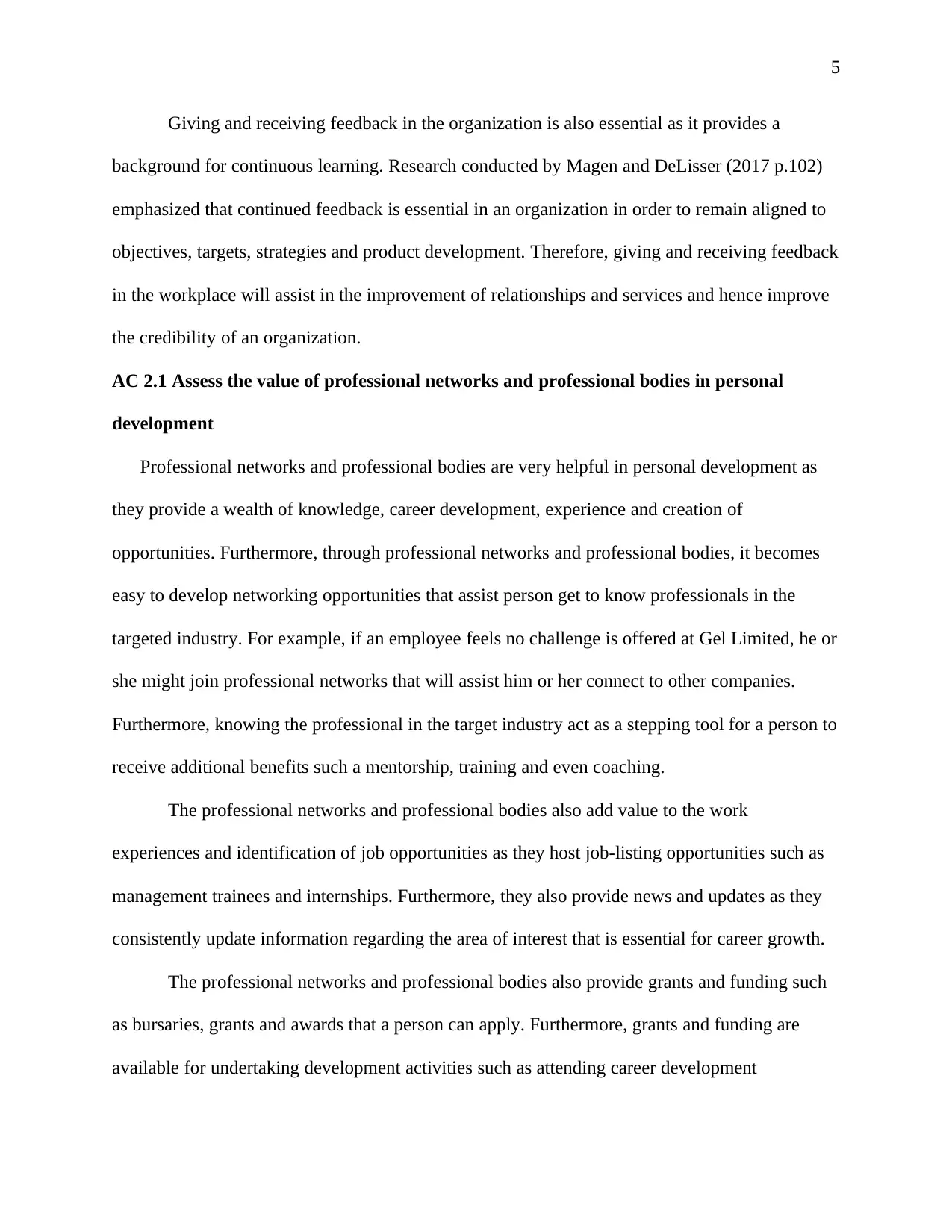
5
Giving and receiving feedback in the organization is also essential as it provides a
background for continuous learning. Research conducted by Magen and DeLisser (2017 p.102)
emphasized that continued feedback is essential in an organization in order to remain aligned to
objectives, targets, strategies and product development. Therefore, giving and receiving feedback
in the workplace will assist in the improvement of relationships and services and hence improve
the credibility of an organization.
AC 2.1 Assess the value of professional networks and professional bodies in personal
development
Professional networks and professional bodies are very helpful in personal development as
they provide a wealth of knowledge, career development, experience and creation of
opportunities. Furthermore, through professional networks and professional bodies, it becomes
easy to develop networking opportunities that assist person get to know professionals in the
targeted industry. For example, if an employee feels no challenge is offered at Gel Limited, he or
she might join professional networks that will assist him or her connect to other companies.
Furthermore, knowing the professional in the target industry act as a stepping tool for a person to
receive additional benefits such a mentorship, training and even coaching.
The professional networks and professional bodies also add value to the work
experiences and identification of job opportunities as they host job-listing opportunities such as
management trainees and internships. Furthermore, they also provide news and updates as they
consistently update information regarding the area of interest that is essential for career growth.
The professional networks and professional bodies also provide grants and funding such
as bursaries, grants and awards that a person can apply. Furthermore, grants and funding are
available for undertaking development activities such as attending career development
Giving and receiving feedback in the organization is also essential as it provides a
background for continuous learning. Research conducted by Magen and DeLisser (2017 p.102)
emphasized that continued feedback is essential in an organization in order to remain aligned to
objectives, targets, strategies and product development. Therefore, giving and receiving feedback
in the workplace will assist in the improvement of relationships and services and hence improve
the credibility of an organization.
AC 2.1 Assess the value of professional networks and professional bodies in personal
development
Professional networks and professional bodies are very helpful in personal development as
they provide a wealth of knowledge, career development, experience and creation of
opportunities. Furthermore, through professional networks and professional bodies, it becomes
easy to develop networking opportunities that assist person get to know professionals in the
targeted industry. For example, if an employee feels no challenge is offered at Gel Limited, he or
she might join professional networks that will assist him or her connect to other companies.
Furthermore, knowing the professional in the target industry act as a stepping tool for a person to
receive additional benefits such a mentorship, training and even coaching.
The professional networks and professional bodies also add value to the work
experiences and identification of job opportunities as they host job-listing opportunities such as
management trainees and internships. Furthermore, they also provide news and updates as they
consistently update information regarding the area of interest that is essential for career growth.
The professional networks and professional bodies also provide grants and funding such
as bursaries, grants and awards that a person can apply. Furthermore, grants and funding are
available for undertaking development activities such as attending career development
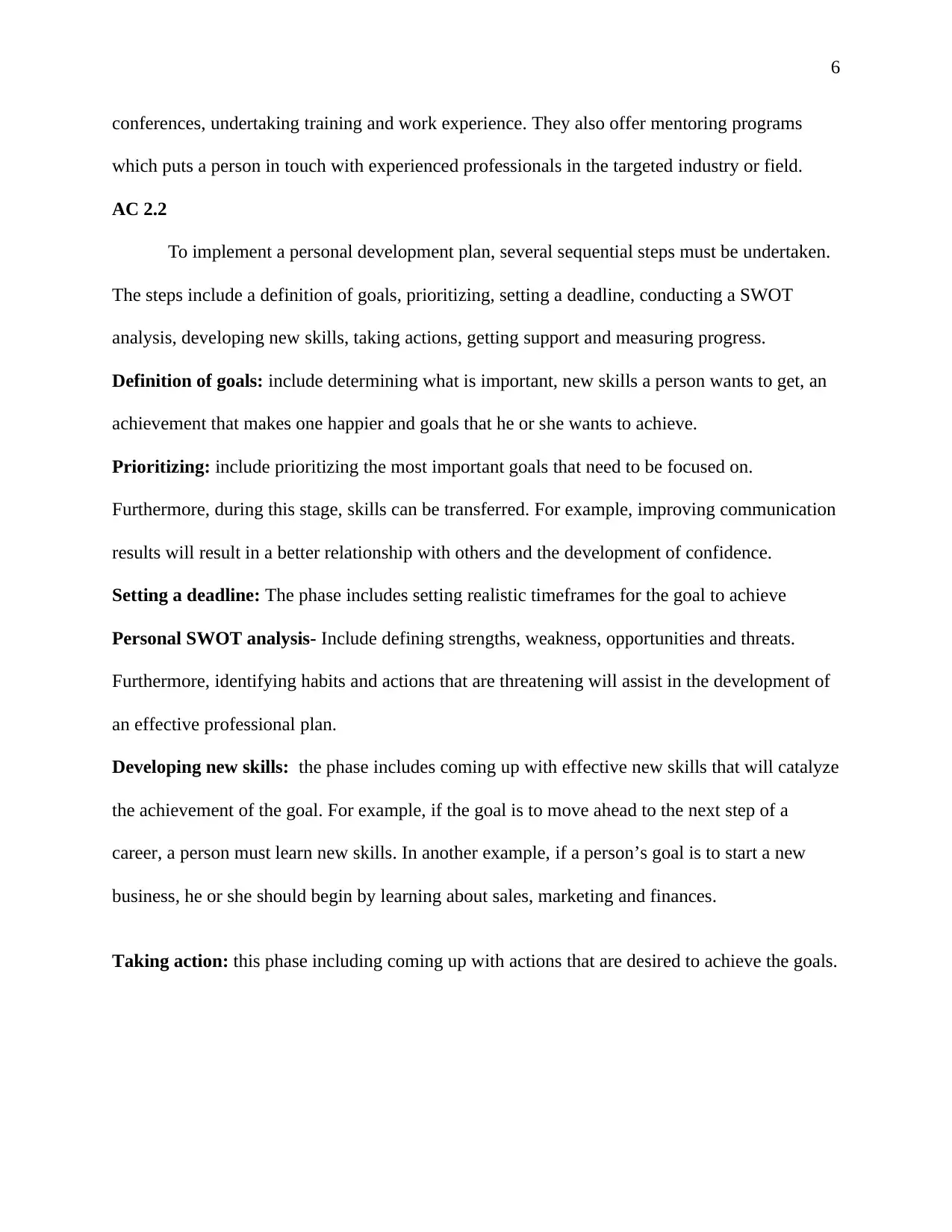
6
conferences, undertaking training and work experience. They also offer mentoring programs
which puts a person in touch with experienced professionals in the targeted industry or field.
AC 2.2
To implement a personal development plan, several sequential steps must be undertaken.
The steps include a definition of goals, prioritizing, setting a deadline, conducting a SWOT
analysis, developing new skills, taking actions, getting support and measuring progress.
Definition of goals: include determining what is important, new skills a person wants to get, an
achievement that makes one happier and goals that he or she wants to achieve.
Prioritizing: include prioritizing the most important goals that need to be focused on.
Furthermore, during this stage, skills can be transferred. For example, improving communication
results will result in a better relationship with others and the development of confidence.
Setting a deadline: The phase includes setting realistic timeframes for the goal to achieve
Personal SWOT analysis- Include defining strengths, weakness, opportunities and threats.
Furthermore, identifying habits and actions that are threatening will assist in the development of
an effective professional plan.
Developing new skills: the phase includes coming up with effective new skills that will catalyze
the achievement of the goal. For example, if the goal is to move ahead to the next step of a
career, a person must learn new skills. In another example, if a person’s goal is to start a new
business, he or she should begin by learning about sales, marketing and finances.
Taking action: this phase including coming up with actions that are desired to achieve the goals.
conferences, undertaking training and work experience. They also offer mentoring programs
which puts a person in touch with experienced professionals in the targeted industry or field.
AC 2.2
To implement a personal development plan, several sequential steps must be undertaken.
The steps include a definition of goals, prioritizing, setting a deadline, conducting a SWOT
analysis, developing new skills, taking actions, getting support and measuring progress.
Definition of goals: include determining what is important, new skills a person wants to get, an
achievement that makes one happier and goals that he or she wants to achieve.
Prioritizing: include prioritizing the most important goals that need to be focused on.
Furthermore, during this stage, skills can be transferred. For example, improving communication
results will result in a better relationship with others and the development of confidence.
Setting a deadline: The phase includes setting realistic timeframes for the goal to achieve
Personal SWOT analysis- Include defining strengths, weakness, opportunities and threats.
Furthermore, identifying habits and actions that are threatening will assist in the development of
an effective professional plan.
Developing new skills: the phase includes coming up with effective new skills that will catalyze
the achievement of the goal. For example, if the goal is to move ahead to the next step of a
career, a person must learn new skills. In another example, if a person’s goal is to start a new
business, he or she should begin by learning about sales, marketing and finances.
Taking action: this phase including coming up with actions that are desired to achieve the goals.
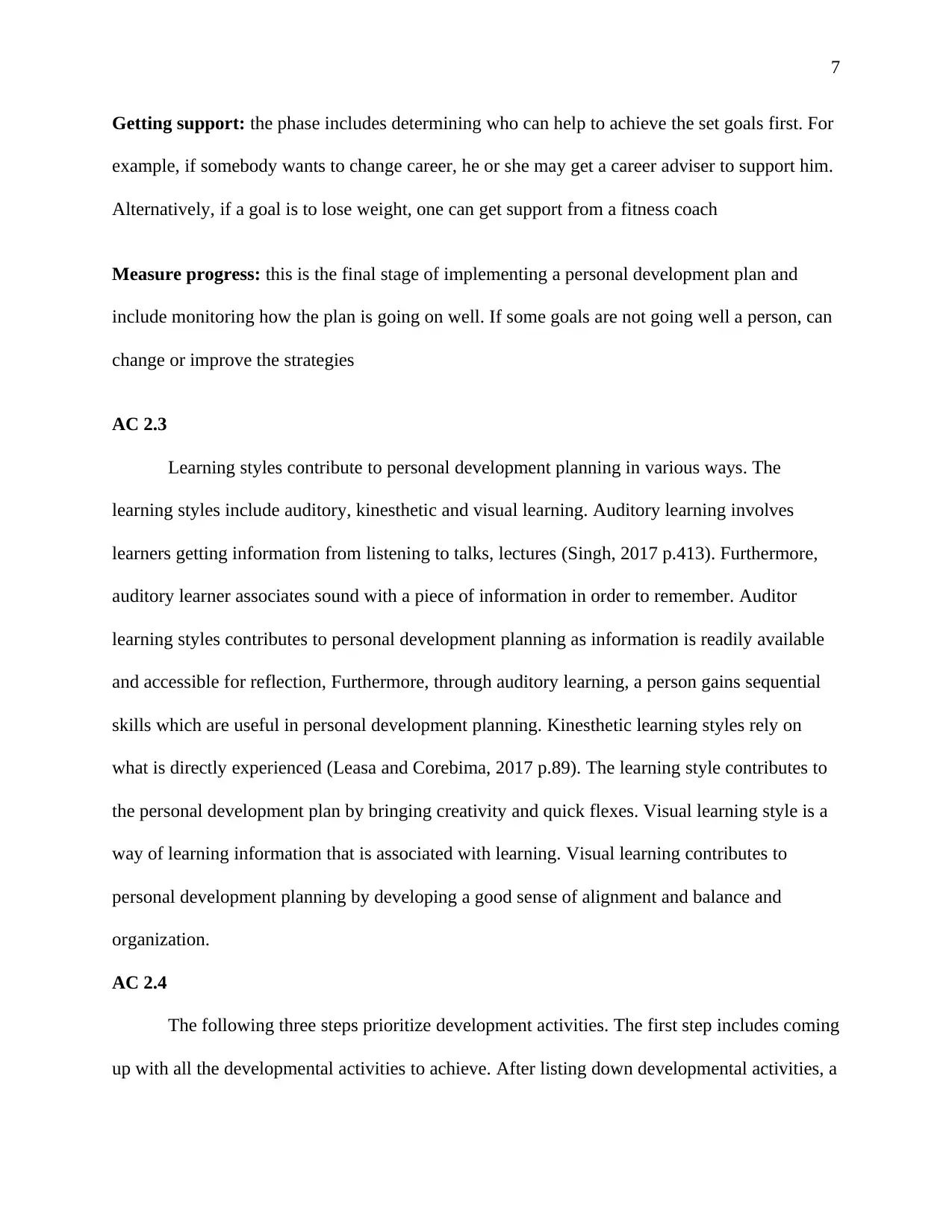
7
Getting support: the phase includes determining who can help to achieve the set goals first. For
example, if somebody wants to change career, he or she may get a career adviser to support him.
Alternatively, if a goal is to lose weight, one can get support from a fitness coach
Measure progress: this is the final stage of implementing a personal development plan and
include monitoring how the plan is going on well. If some goals are not going well a person, can
change or improve the strategies
AC 2.3
Learning styles contribute to personal development planning in various ways. The
learning styles include auditory, kinesthetic and visual learning. Auditory learning involves
learners getting information from listening to talks, lectures (Singh, 2017 p.413). Furthermore,
auditory learner associates sound with a piece of information in order to remember. Auditor
learning styles contributes to personal development planning as information is readily available
and accessible for reflection, Furthermore, through auditory learning, a person gains sequential
skills which are useful in personal development planning. Kinesthetic learning styles rely on
what is directly experienced (Leasa and Corebima, 2017 p.89). The learning style contributes to
the personal development plan by bringing creativity and quick flexes. Visual learning style is a
way of learning information that is associated with learning. Visual learning contributes to
personal development planning by developing a good sense of alignment and balance and
organization.
AC 2.4
The following three steps prioritize development activities. The first step includes coming
up with all the developmental activities to achieve. After listing down developmental activities, a
Getting support: the phase includes determining who can help to achieve the set goals first. For
example, if somebody wants to change career, he or she may get a career adviser to support him.
Alternatively, if a goal is to lose weight, one can get support from a fitness coach
Measure progress: this is the final stage of implementing a personal development plan and
include monitoring how the plan is going on well. If some goals are not going well a person, can
change or improve the strategies
AC 2.3
Learning styles contribute to personal development planning in various ways. The
learning styles include auditory, kinesthetic and visual learning. Auditory learning involves
learners getting information from listening to talks, lectures (Singh, 2017 p.413). Furthermore,
auditory learner associates sound with a piece of information in order to remember. Auditor
learning styles contributes to personal development planning as information is readily available
and accessible for reflection, Furthermore, through auditory learning, a person gains sequential
skills which are useful in personal development planning. Kinesthetic learning styles rely on
what is directly experienced (Leasa and Corebima, 2017 p.89). The learning style contributes to
the personal development plan by bringing creativity and quick flexes. Visual learning style is a
way of learning information that is associated with learning. Visual learning contributes to
personal development planning by developing a good sense of alignment and balance and
organization.
AC 2.4
The following three steps prioritize development activities. The first step includes coming
up with all the developmental activities to achieve. After listing down developmental activities, a
Paraphrase This Document
Need a fresh take? Get an instant paraphrase of this document with our AI Paraphraser
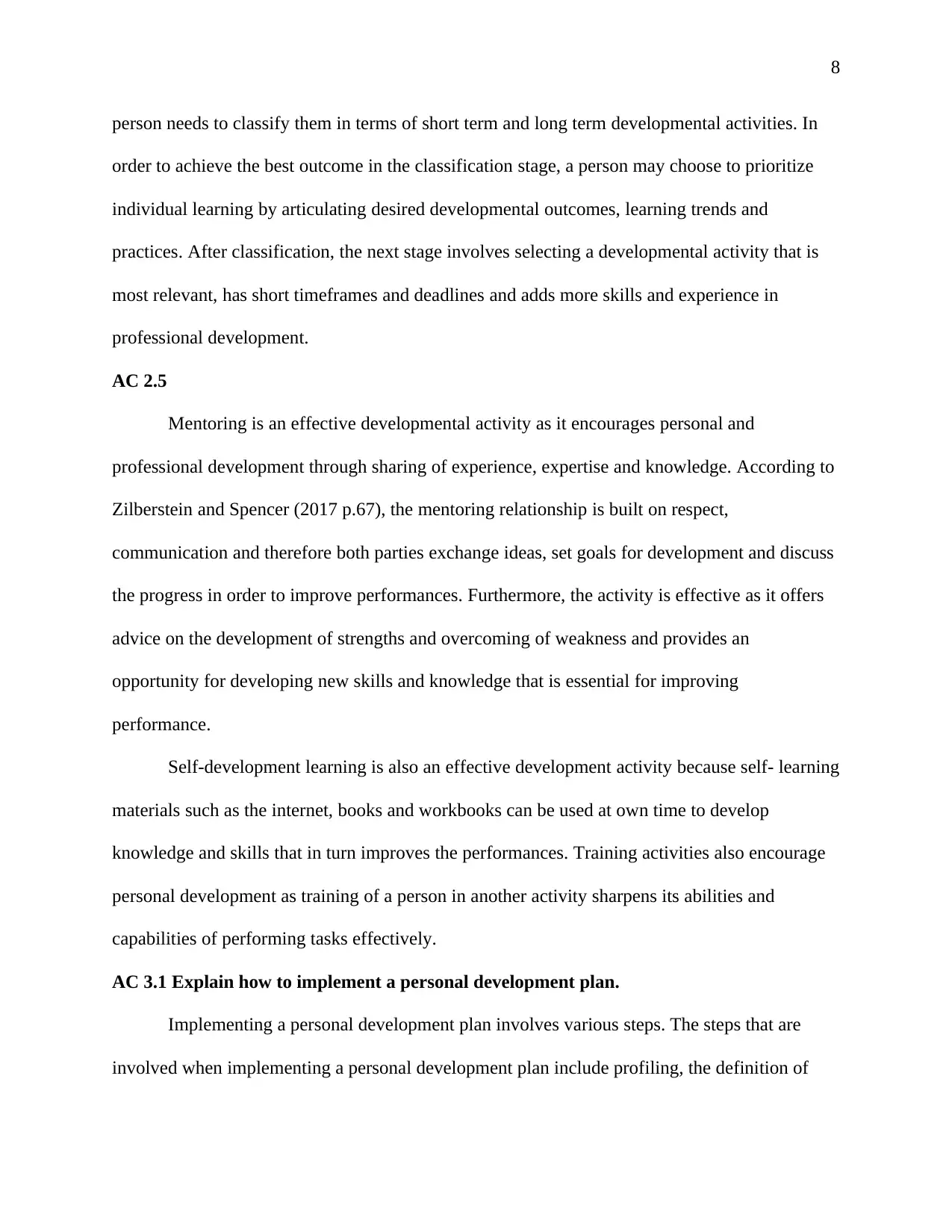
8
person needs to classify them in terms of short term and long term developmental activities. In
order to achieve the best outcome in the classification stage, a person may choose to prioritize
individual learning by articulating desired developmental outcomes, learning trends and
practices. After classification, the next stage involves selecting a developmental activity that is
most relevant, has short timeframes and deadlines and adds more skills and experience in
professional development.
AC 2.5
Mentoring is an effective developmental activity as it encourages personal and
professional development through sharing of experience, expertise and knowledge. According to
Zilberstein and Spencer (2017 p.67), the mentoring relationship is built on respect,
communication and therefore both parties exchange ideas, set goals for development and discuss
the progress in order to improve performances. Furthermore, the activity is effective as it offers
advice on the development of strengths and overcoming of weakness and provides an
opportunity for developing new skills and knowledge that is essential for improving
performance.
Self-development learning is also an effective development activity because self- learning
materials such as the internet, books and workbooks can be used at own time to develop
knowledge and skills that in turn improves the performances. Training activities also encourage
personal development as training of a person in another activity sharpens its abilities and
capabilities of performing tasks effectively.
AC 3.1 Explain how to implement a personal development plan.
Implementing a personal development plan involves various steps. The steps that are
involved when implementing a personal development plan include profiling, the definition of
person needs to classify them in terms of short term and long term developmental activities. In
order to achieve the best outcome in the classification stage, a person may choose to prioritize
individual learning by articulating desired developmental outcomes, learning trends and
practices. After classification, the next stage involves selecting a developmental activity that is
most relevant, has short timeframes and deadlines and adds more skills and experience in
professional development.
AC 2.5
Mentoring is an effective developmental activity as it encourages personal and
professional development through sharing of experience, expertise and knowledge. According to
Zilberstein and Spencer (2017 p.67), the mentoring relationship is built on respect,
communication and therefore both parties exchange ideas, set goals for development and discuss
the progress in order to improve performances. Furthermore, the activity is effective as it offers
advice on the development of strengths and overcoming of weakness and provides an
opportunity for developing new skills and knowledge that is essential for improving
performance.
Self-development learning is also an effective development activity because self- learning
materials such as the internet, books and workbooks can be used at own time to develop
knowledge and skills that in turn improves the performances. Training activities also encourage
personal development as training of a person in another activity sharpens its abilities and
capabilities of performing tasks effectively.
AC 3.1 Explain how to implement a personal development plan.
Implementing a personal development plan involves various steps. The steps that are
involved when implementing a personal development plan include profiling, the definition of
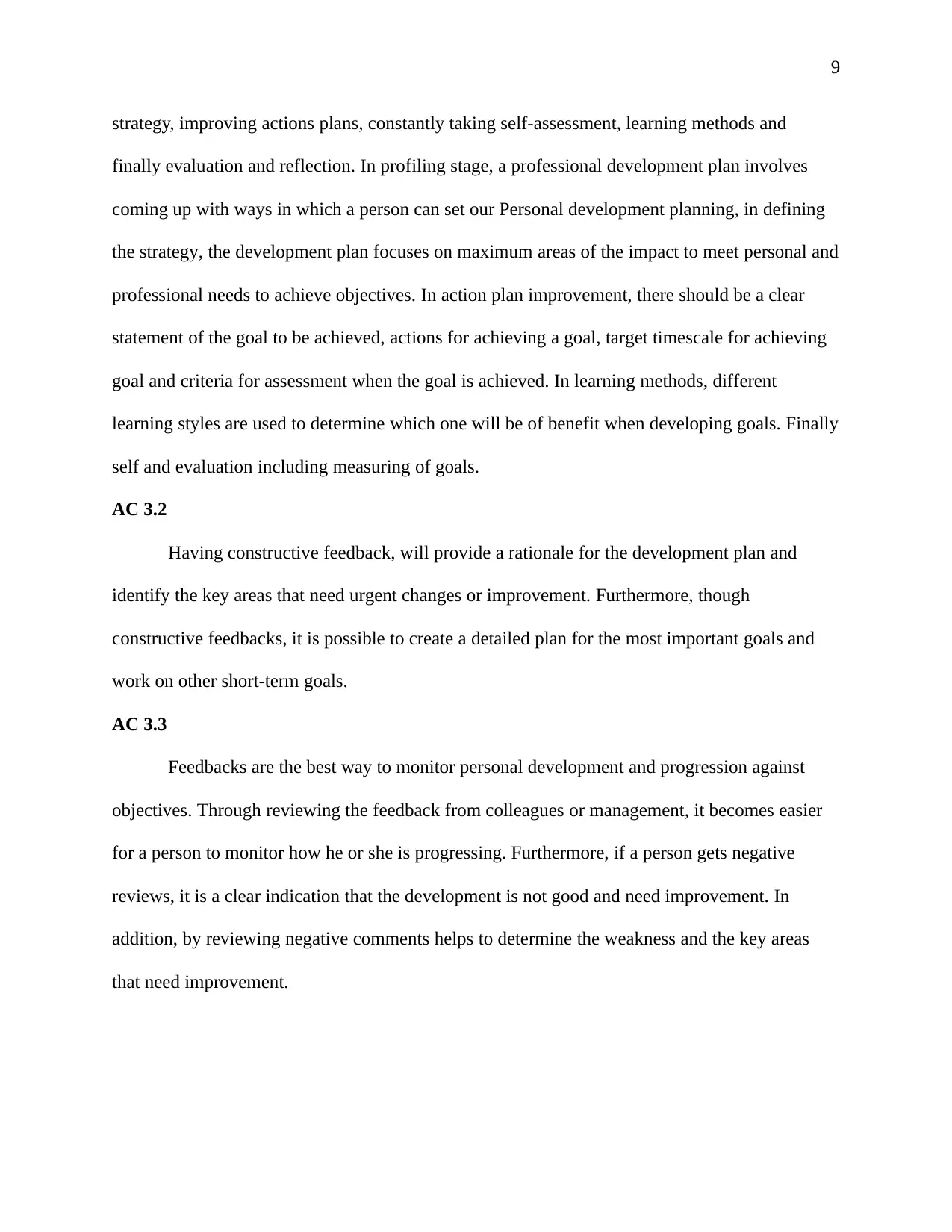
9
strategy, improving actions plans, constantly taking self-assessment, learning methods and
finally evaluation and reflection. In profiling stage, a professional development plan involves
coming up with ways in which a person can set our Personal development planning, in defining
the strategy, the development plan focuses on maximum areas of the impact to meet personal and
professional needs to achieve objectives. In action plan improvement, there should be a clear
statement of the goal to be achieved, actions for achieving a goal, target timescale for achieving
goal and criteria for assessment when the goal is achieved. In learning methods, different
learning styles are used to determine which one will be of benefit when developing goals. Finally
self and evaluation including measuring of goals.
AC 3.2
Having constructive feedback, will provide a rationale for the development plan and
identify the key areas that need urgent changes or improvement. Furthermore, though
constructive feedbacks, it is possible to create a detailed plan for the most important goals and
work on other short-term goals.
AC 3.3
Feedbacks are the best way to monitor personal development and progression against
objectives. Through reviewing the feedback from colleagues or management, it becomes easier
for a person to monitor how he or she is progressing. Furthermore, if a person gets negative
reviews, it is a clear indication that the development is not good and need improvement. In
addition, by reviewing negative comments helps to determine the weakness and the key areas
that need improvement.
strategy, improving actions plans, constantly taking self-assessment, learning methods and
finally evaluation and reflection. In profiling stage, a professional development plan involves
coming up with ways in which a person can set our Personal development planning, in defining
the strategy, the development plan focuses on maximum areas of the impact to meet personal and
professional needs to achieve objectives. In action plan improvement, there should be a clear
statement of the goal to be achieved, actions for achieving a goal, target timescale for achieving
goal and criteria for assessment when the goal is achieved. In learning methods, different
learning styles are used to determine which one will be of benefit when developing goals. Finally
self and evaluation including measuring of goals.
AC 3.2
Having constructive feedback, will provide a rationale for the development plan and
identify the key areas that need urgent changes or improvement. Furthermore, though
constructive feedbacks, it is possible to create a detailed plan for the most important goals and
work on other short-term goals.
AC 3.3
Feedbacks are the best way to monitor personal development and progression against
objectives. Through reviewing the feedback from colleagues or management, it becomes easier
for a person to monitor how he or she is progressing. Furthermore, if a person gets negative
reviews, it is a clear indication that the development is not good and need improvement. In
addition, by reviewing negative comments helps to determine the weakness and the key areas
that need improvement.
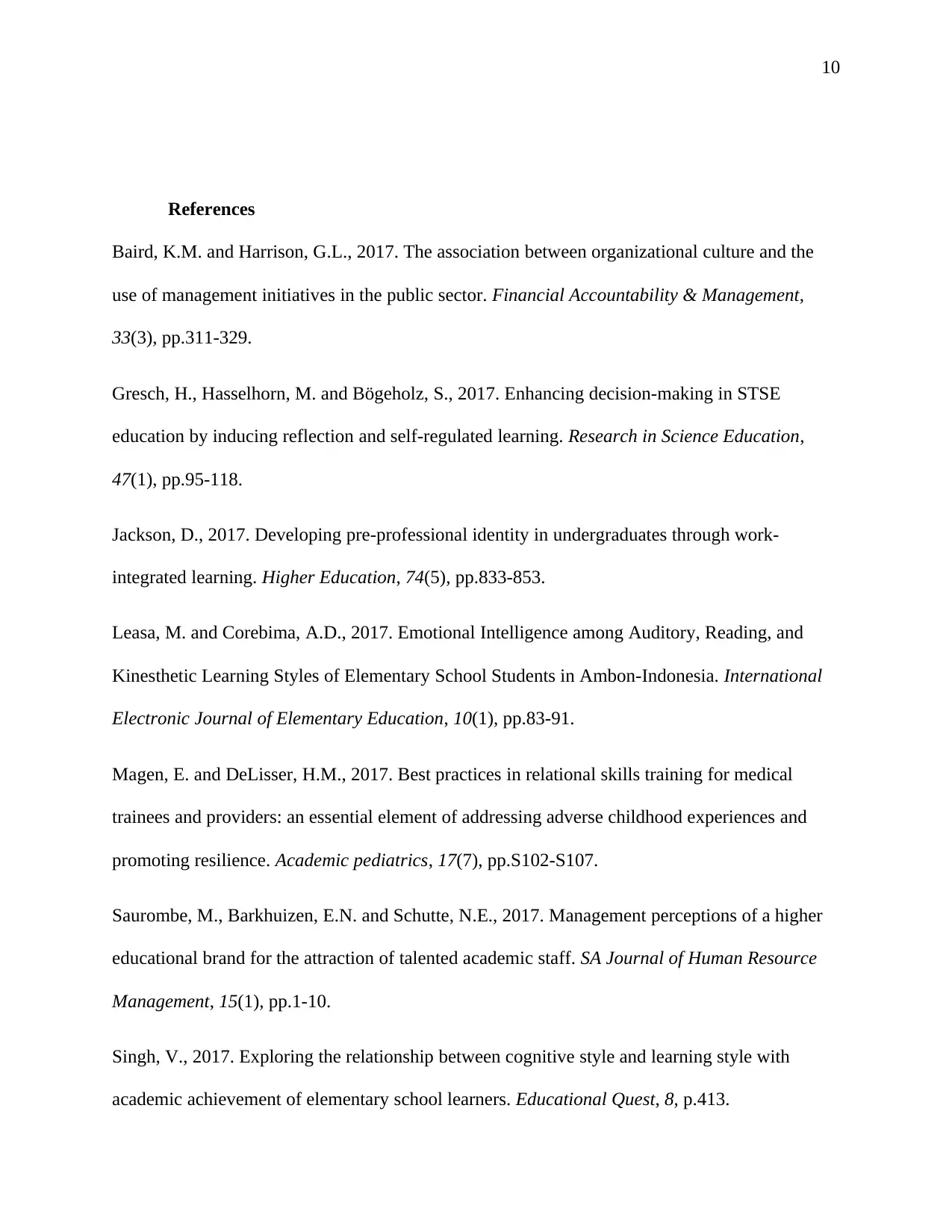
10
References
Baird, K.M. and Harrison, G.L., 2017. The association between organizational culture and the
use of management initiatives in the public sector. Financial Accountability & Management,
33(3), pp.311-329.
Gresch, H., Hasselhorn, M. and Bögeholz, S., 2017. Enhancing decision-making in STSE
education by inducing reflection and self-regulated learning. Research in Science Education,
47(1), pp.95-118.
Jackson, D., 2017. Developing pre-professional identity in undergraduates through work-
integrated learning. Higher Education, 74(5), pp.833-853.
Leasa, M. and Corebima, A.D., 2017. Emotional Intelligence among Auditory, Reading, and
Kinesthetic Learning Styles of Elementary School Students in Ambon-Indonesia. International
Electronic Journal of Elementary Education, 10(1), pp.83-91.
Magen, E. and DeLisser, H.M., 2017. Best practices in relational skills training for medical
trainees and providers: an essential element of addressing adverse childhood experiences and
promoting resilience. Academic pediatrics, 17(7), pp.S102-S107.
Saurombe, M., Barkhuizen, E.N. and Schutte, N.E., 2017. Management perceptions of a higher
educational brand for the attraction of talented academic staff. SA Journal of Human Resource
Management, 15(1), pp.1-10.
Singh, V., 2017. Exploring the relationship between cognitive style and learning style with
academic achievement of elementary school learners. Educational Quest, 8, p.413.
References
Baird, K.M. and Harrison, G.L., 2017. The association between organizational culture and the
use of management initiatives in the public sector. Financial Accountability & Management,
33(3), pp.311-329.
Gresch, H., Hasselhorn, M. and Bögeholz, S., 2017. Enhancing decision-making in STSE
education by inducing reflection and self-regulated learning. Research in Science Education,
47(1), pp.95-118.
Jackson, D., 2017. Developing pre-professional identity in undergraduates through work-
integrated learning. Higher Education, 74(5), pp.833-853.
Leasa, M. and Corebima, A.D., 2017. Emotional Intelligence among Auditory, Reading, and
Kinesthetic Learning Styles of Elementary School Students in Ambon-Indonesia. International
Electronic Journal of Elementary Education, 10(1), pp.83-91.
Magen, E. and DeLisser, H.M., 2017. Best practices in relational skills training for medical
trainees and providers: an essential element of addressing adverse childhood experiences and
promoting resilience. Academic pediatrics, 17(7), pp.S102-S107.
Saurombe, M., Barkhuizen, E.N. and Schutte, N.E., 2017. Management perceptions of a higher
educational brand for the attraction of talented academic staff. SA Journal of Human Resource
Management, 15(1), pp.1-10.
Singh, V., 2017. Exploring the relationship between cognitive style and learning style with
academic achievement of elementary school learners. Educational Quest, 8, p.413.
Secure Best Marks with AI Grader
Need help grading? Try our AI Grader for instant feedback on your assignments.

11
Zilberstein, K. and Spencer, R., 2017. Breaking bad: An attachment perspective on youth
mentoring relationship closures. Child & Family Social Work, 22(1), pp.67-76.
Zilberstein, K. and Spencer, R., 2017. Breaking bad: An attachment perspective on youth
mentoring relationship closures. Child & Family Social Work, 22(1), pp.67-76.
1 out of 11
Related Documents
Your All-in-One AI-Powered Toolkit for Academic Success.
+13062052269
info@desklib.com
Available 24*7 on WhatsApp / Email
![[object Object]](/_next/static/media/star-bottom.7253800d.svg)
Unlock your academic potential
© 2024 | Zucol Services PVT LTD | All rights reserved.





